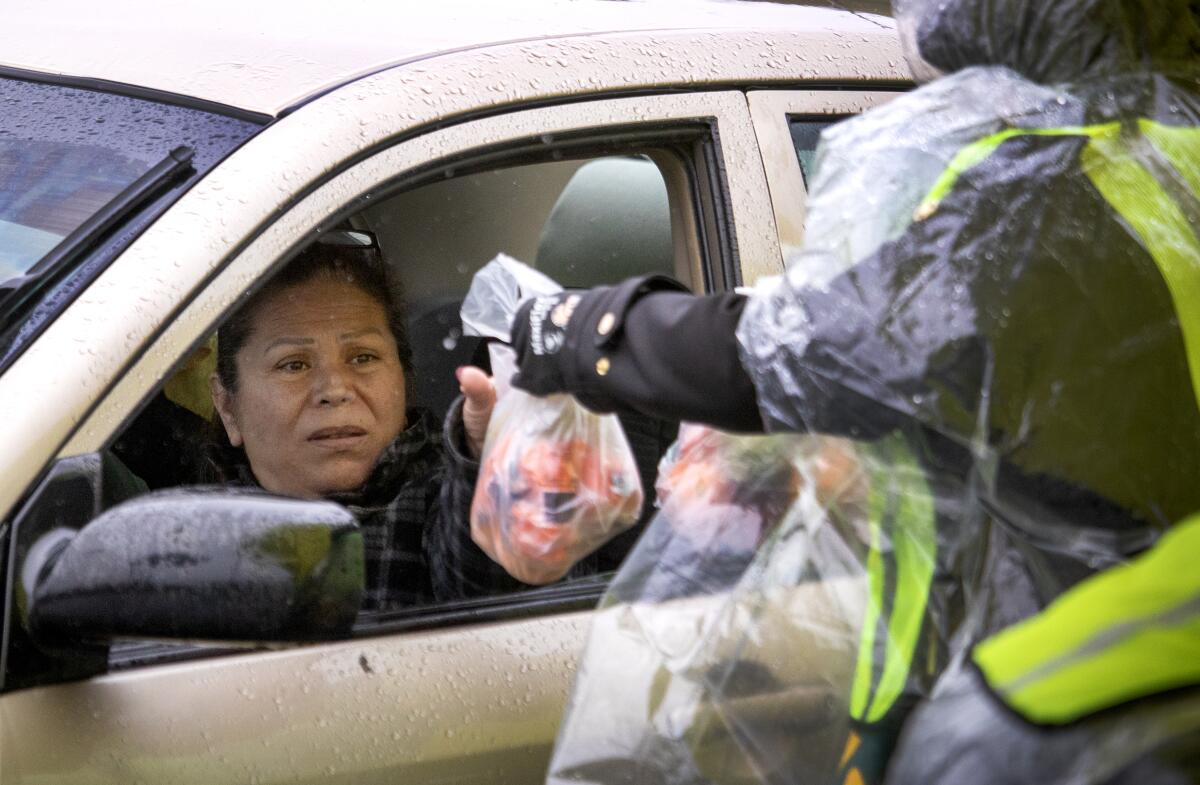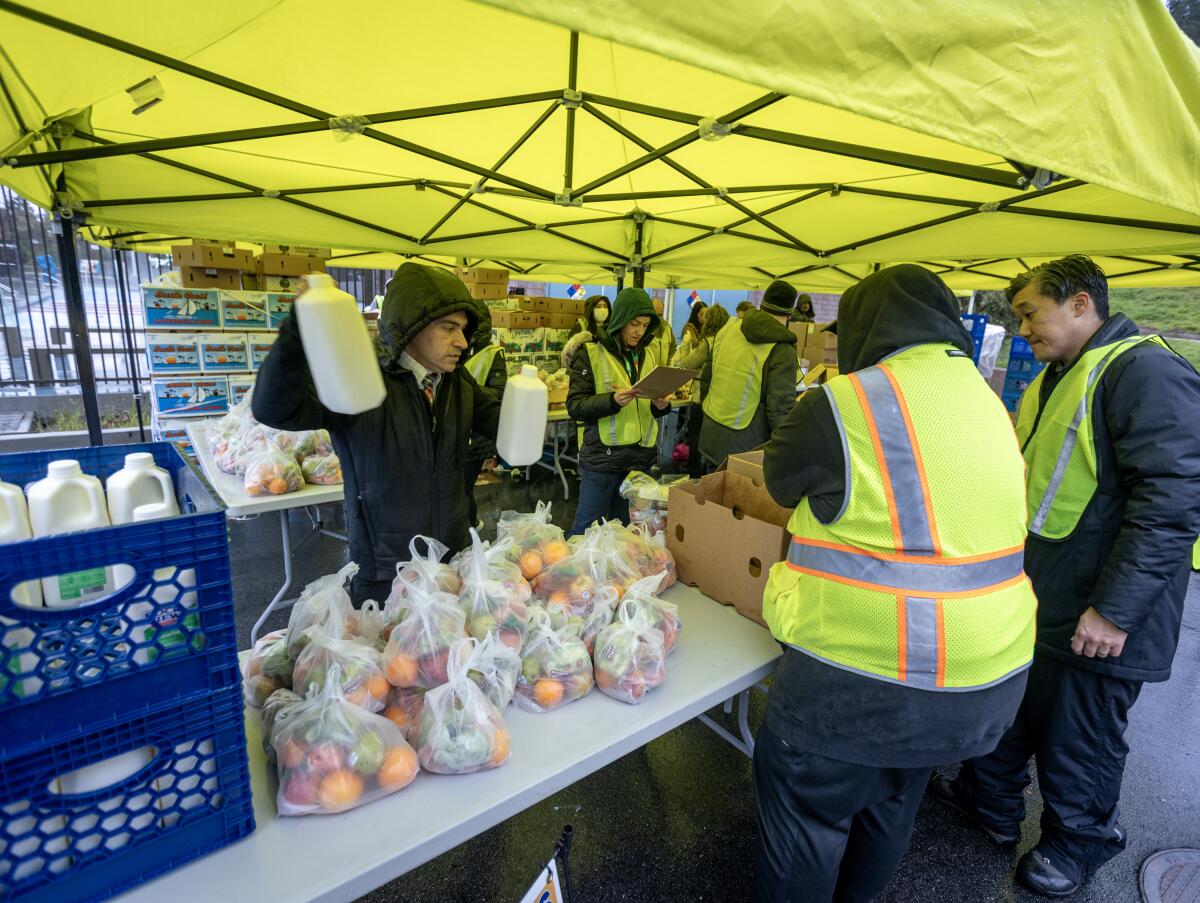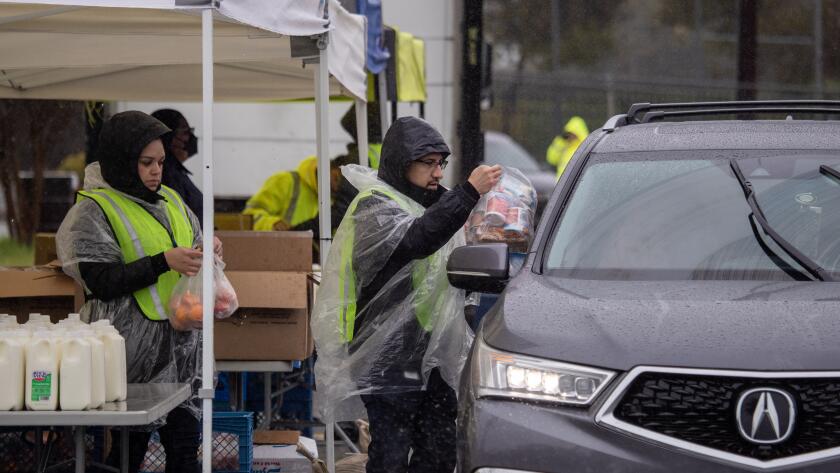Parents brave the rain to secure three days of food for their children
- Share via
With classes likely to be canceled throughout LAUSD on Tuesday, Wednesday and Thursday, here are some ways to get free meals for students who would usually be fed at school.
- Share via
Benita Perez was the first in line. The rain poured steadily down, but she wanted to get enough food for her grandchildren to tide them over during the three-day Los Angeles Unified School District strike.
Fearing a long wait, Perez and a friend arrived Tuesday at 6:30 a.m., an hour before the food distribution site opened at Lincoln Park Recreation Center. They watched from inside an SUV as volunteers under neon-green tents filled bags with pears, oranges, apples, celery and carrots. Another bag held 2-ounce cups of Cinnamon Chex cereal, whole-grain cookies, heat-and-serve pizza, cheese-and-cracker packs and juice boxes — six breakfasts and lunches for each student.
Perez, who lives in Lincoln Heights and cleans houses for a living, said the family’s income for the last month has all gone toward the $2,700 rent. They are behind more than $1,000 on the electric bill. With the strike, she said, she’s worried about feeding her four grandchildren.
“We need more food in the house,” the 56-year-old said. “We’re preparing for these three days so the kids can open the fridge and have something to eat.”
The majority of LAUSD’s 420,000 students come from low-income families — many of whom face food insecurity even without the disruption of a strike. On a typical day, the nation’s second-largest school district provides hundreds of thousands of meals.
But with the support staff who normally pack and serve meals on strike amid long-running contract talks, and with teachers joining them in solidarity, the district had to find other ways to provide food for the families in its care.

Over about three hours, workers Tuesday distributed 124,596 meals.
“It’s just keeping the consistency going. We have students that need to eat,” said José Huerta, the east regional superintendent for LAUSD, as he handed out half gallons of milk at a distribution site in El Sereno. “It’s important that the kids have something available to them in our community.”
Strikers are protesting for better wages and working conditions for some of the district’s lowest-paid employees: bus drivers, custodians, special-education assistants, cafeteria workers and others. The employees, joined in solidarity by the teachers union, shuttered the vast school system after last-minute efforts to avert the strike failed, disrupting classes, vital meal services and daily routines.
By 7:12 a.m., even before the official opening, workers outside the Lincoln Park recreation center had distributed nearly 100 meals. The operation moved like a pit stop on a racetrack, with some workers loading jugs of milk into the passenger seat, while others placed bags into the trunk. Families were often in and out within 15 seconds.
Ana Villasano, 33, was picking up food for her 9- and 11-year-old sons. She has had to take three days off work at a chocolate and nut company in Ontario because she doesn’t have anyone to watch the kids. Her husband has to leave for his delivery job at about 3 a.m.
“Not having this money is really going to impact me and really impact what we have to eat,” said Villasano, who lives in City Terrace. She told her kids they would have to eat “whatever they’re able to give us” at the Lincoln Park distribution center.
Villasano said she supports the strike — despite the difficulties it is causing her family.
“I would like them to get better wages,” she said of school workers. “I hope they reach an agreement, because they deserve it.”
At El Sereno Recreation Center, Irania Barrientos, a custodian at an LAUSD middle school, dropped by with her 5-year-old son to grab food. Barrientos, who wore a purple union shirt, said custodians are paid only a few dollars more than minimum wage, “and it’s still not enough to make ends meet.”
Barrientos, a single mom, said she has to work overtime just to get by. She pays $1,400 a month for a one-bedroom apartment in El Sereno. That morning, her son, who attends school in the district, told her he was hungry. So before joining the picket line at LAUSD headquarters, they headed to the nearest food distribution center.
“This is going to help through the day that we’re out there and a few [other] days too,” she said.
Some of the workers who normally feed students every day were out in force — joining picket lines instead of handing out breakfast in a school cafeteria.

Margarita Gasca, 48, is a food-service worker at Parmelee Avenue Elementary in South L.A. On Tuesday morning, she was bundled up in thick, black boots, a heavy coat and a beanie. She has worked at Parmelee for a year but has been with the school district for 16. She makes $16.91 an hour and said she feels she is “basically working for benefits.”
She said food-service workers at her school each day prepare about 700 breakfasts (which are placed in bags that students take to class), about 800 lunches and more than 100 suppers. They cook, fill plates, do the dishes, clean the kitchen, take the kids’ names, input them in the computer system and serve the meals.
“They pay us too low for the work that we do,” Gasca said.
Volunteers at food distribution sites were getting a taste of families’ needs throughout the rainy morning.
In front of the Glassell Park Recreation Center, the line was 20 vehicles deep along Verdugo Road. The operation was supposed to end at 10:30 a.m., but distribution continued for another half hour to accommodate everyone.
“We’re in shock, because we were not expecting this many people to come,” said Carla Rosales, a food-service employee who has worked for the district for 10 years and declined to talk about the strike or her own circumstances. “They haven’t stopped, and the rain hasn’t stopped.”
The atmosphere was cheerful at the distribution center at Pan Pacific Park. After a brief early-morning rush, with more than 50 cars trailing down the block, the site saw a steady flow of minivans, SUVs and sporty compacts pass through for grab-and-go meals.
In the auditorium, LAUSD staff who were not part of the two striking unions put together bags of fresh fruit, single-serving cereal bowls and quarts of 1% milk to hand out to families.
Baasansuren Altanchimeg, a nail tech, brought her two children with her from Koreatown to pick up food around 10 a.m. Bujin, 5, is in transitional kindergarten at Third Street Elementary School, while Brian, 3, attends an LAUSD preschool program in Chinatown.
“I had to call in to work saying school is closed, I cannot work,” Altanchimeg, 27, lamented. She would not only lose her wages for the duration of the strike but worried about being able to continue her own classes with her little ones home.
“For three days, it’s so hard, because I also go to school,” said Altanchimeg, who is training to become a dental assistant. “Tomorrow I have to ask my friend to take care of my kids, because I can’t miss school.”
Ernesto Martinez drove to the food distribution center straight from his night shift in a Santa Monica warehouse. He’d started his shift at 10 p.m. and managed to squeak into the distribution line in the parking lot at Pan Pacific Park in Fairfax at 10:15 a.m., just before closing.
“Times are rough; you gotta come and do it. My wife was like, ‘Don’t forget to pick up food for the kids,’” said Martinez, who lives in the Dockweiler neighborhood near Mid-City. “It’s rough, because if they don’t go to school for three days, it adds up.”
Times staff writer Andrew Campa contributed to this report.
More to Read
Sign up for Essential California
The most important California stories and recommendations in your inbox every morning.
You may occasionally receive promotional content from the Los Angeles Times.














